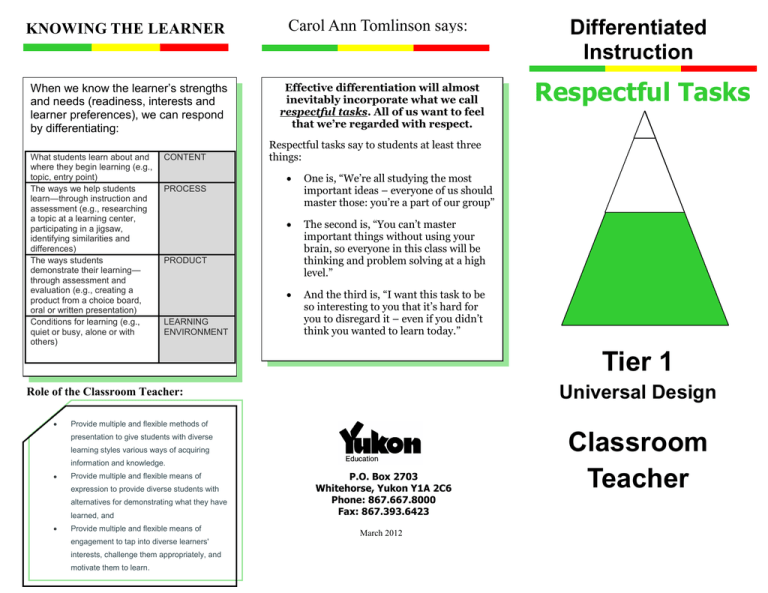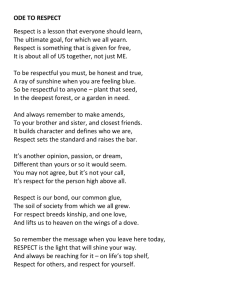Tier 1 Classroom Teacher
advertisement

KNOWING THE LEARNER When we know the learner’s strengths and needs (readiness, interests and learner preferences), we can respond by differentiating: What students learn about and where they begin learning (e.g., topic, entry point) The ways we help students learn—through instruction and assessment (e.g., researching a topic at a learning center, participating in a jigsaw, identifying similarities and differences) The ways students demonstrate their learning— through assessment and evaluation (e.g., creating a product from a choice board, oral or written presentation) Conditions for learning (e.g., quiet or busy, alone or with others) CONTENT Carol Ann Tomlinson says: Effective differentiation will almost inevitably incorporate what we call respectful tasks. All of us want to feel that we’re regarded with respect. Respectful Tasks Respectful tasks say to students at least three things: One is, “We’re all studying the most important ideas – everyone of us should master those: you’re a part of our group” The second is, “You can’t master important things without using your brain, so everyone in this class will be thinking and problem solving at a high level.” And the third is, “I want this task to be so interesting to you that it’s hard for you to disregard it – even if you didn’t think you wanted to learn today.” PROCESS PRODUCT LEARNING ENVIRONMENT Differentiated Instruction Tier 1 Universal Design Role of the Classroom Teacher: Provide multiple and flexible methods of presentation to give students with diverse learning styles various ways of acquiring information and knowledge. Provide multiple and flexible means of expression to provide diverse students with alternatives for demonstrating what they have learned, and Provide multiple and flexible means of engagement to tap into diverse learners' interests, challenge them appropriately, and motivate them to learn. P.O. Box 2703 Whitehorse, Yukon Y1A 2C6 Phone: 867.667.8000 Fax: 867.393.6423 March 2012 Classroom Teacher RESPECTFUL TASKS High-Quality Curriculum Respectful tasks are learning experiences matched to the needs of the student. Tasks that are respectful of the learner honor the differences among students’ readiness levels (appropriately rigorous), areas of interest (engage the learner), and learning profile (attends to learner processing) QUESTIONS TO CONSIDER: 1. What do I want students to understand and be able to do? 2. Who are the students and what do they know? 3. How will I connect “the what” I teach with those I teach? 4. Which instructional tools, resources, and strategies will fit with what the students need? Example Instructional Strategies * Reader’s workshop * Writer’s Workshop * Literature Circles * Information Circles * Choice Boards – RAFT and Think-Tac-Toe * Project-based Learning Respectful tasks recognize student learning differences. The teacher continually tries to understand what individual strengths students need to learn most effectively. A respectful task honors both commonalities and differences of students but not by treating them alike. - Carol Ann Tomlinson * Venn Diagram to assign work Choice Everyone Choice #3, #4 #1, #2 #5, #6 * Jigsaw readings/learning tasks * Learning centers/stations RESPECTFUL TASKS LOOK LIKE: All choices/tasks are interesting and engaging All choices/tasks require the students to work at the edge of their current readiness All choices/tasks are based on the same learning goal All choices/tasks can be assessed using the same success criteria, which have been identified, shared with, and understood by students Students having difficulty with a concept are engaged in learning opportunities that are just as interesting and appealing as those of other students Reference: Redefining Fair: How to plan, Assess, and Grade for Excellence in Mix-ability Classrooms. –Damian Cooper Website: http://www.edugains.ca/resourcesDI/Educators Packages/DIEducatorsPackage2010/2010RefCa rd2.pdf
